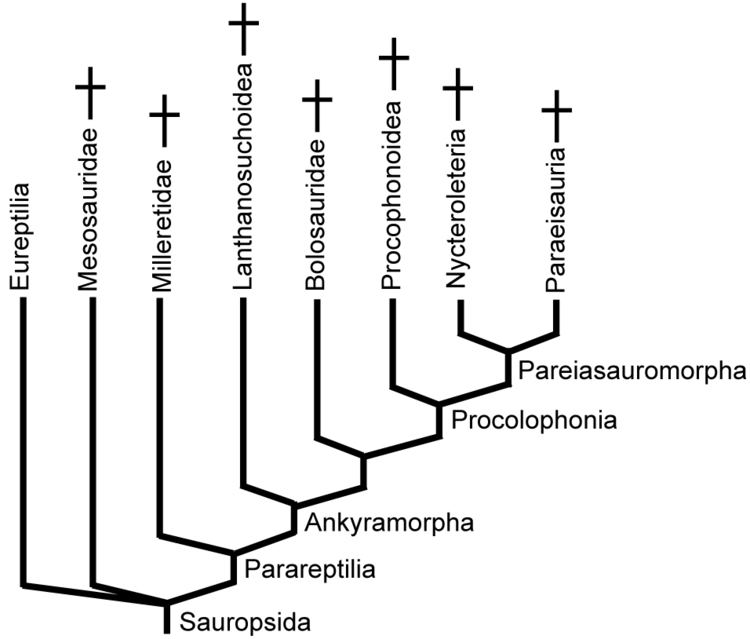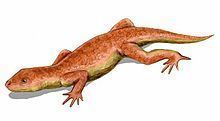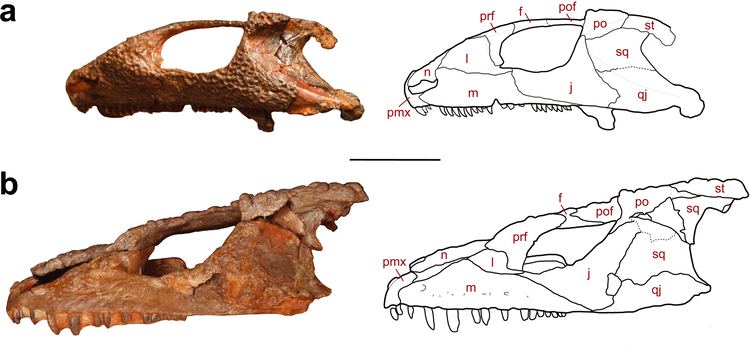Higher classification Reptile | Phylum Chordata Rank Subclass | |
Clade †ParareptiliaOlson, 1947 Similar Reptile, Procolophonidae, Pareiasaur, Eureptilia, Procolophonoidea | ||
Diversity and body size evolution in parareptilia
Parareptilia ("at the side of reptiles") is a subclass or clade of reptiles which is variously defined as an extinct group of primitive anapsids, or a more cladistically correct alternative to Anapsida. Whether the term is valid depends on the phylogenetic position of turtles, whose relationships to other reptilian groups are still uncertain.
Contents
History of classification

The name Parareptilia was coined by Olson in 1947 to refer to an extinct group of Paleozoic reptiles, as opposed to the rest of the reptiles or Eureptilia ("true reptiles").

The name fell into disuse until it was revived by cladistic studies, to refer to those anapsids that were thought to be unrelated to turtles. Gauthier et al. 1988 provided the first phylogenetic definitions for the names of many amniote taxa and argued that captorhinids and turtles were sister groups, constituting the clade Anapsida (in a much more limited context than the definition given by Romer in 1967). A name had to be found for various Permian and Triassic reptiles no longer included in the anapsids, and "parareptiles" was chosen. However, they did not feel confident enough to erect Parareptilia as a formal taxon. Their cladogram was as follows:

Laurin and Reisz 1995 found a different cladogram, in which Reptilia were divided into Parareptilia (now a formal taxon they defined as ‘‘Testudines and all amniotes more closely related to them than to diapsids.’’) and Eureptilia. Captorhinidae was transferred to Eureptilia, and Parareptilia included both early anapsid reptiles and turtles. The mesosaurs were placed outside both groups, as the sister group to the reptiles (but still sauropsids). The traditional group Anapsida was rejected as paraphyletic. This gave the following result:

In contrast, Rieppel, 1994, 1995; Rieppel & deBraga, 1996; and deBraga & Rieppel, 1997 argued that turtles are actually related to the sauropterygians, and are diapsids. The diapsid affinities of turtles have been supported by molecular phylogenies (e.g. Zardoya and Meyer 1998; Iwabe et al., 2004; Roos et al., 2007; Katsu et al., 2010). The first genome-wide phylogenetic analysis was completed by Wang et al. (2013). Using the draft genomes of Chelonia mydas and Pelodiscus sinensis, the team used the largest turtle data set to date in their analysis and concluded that turtles are likely a sister group of crocodilians and birds (Archosauria). This placement within the diapsids suggests that the turtle lineage lost diapsid skull characteristics as it now possesses an anapsid skull. This would make Parareptilia a totally extinct group with skull features that coincidentally resemble those of turtles.
The cladogram below follows an analysis by M.S. Lee, in 2013.
